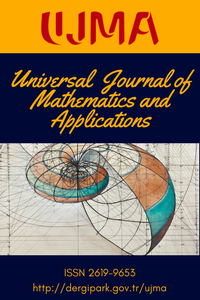Generalized Rayleigh-Quotient Formulas for the Real Parts, Imaginary Parts, and Moduli of the Eigenvalues of General Matrices
Generalized Rayleigh-Quotient Formulas for the Real Parts, Imaginary Parts, and Moduli of the Eigenvalues of General Matrices
General (not necessarily diagonalizable) matrix, Real and imaginary parts of eigenvalues; Generalized Rayleigh-quotient formulas, Generalized numerical range System matrix of a linear dynamical problem,
___
- [1] R.T. Gregory, D.L. Karney, A Collection of Matrices for Testing Computational Algorithms, Wiley-Interscience, New York, London Sydney Toronto, 1969.
- [2] R.A. Horn, Ch.R. Johnson, Matrix Analysis, University Press, Cambridge, 22nd printing, 2009.
- [3] R.A. Horn, Ch.R. Johnson, Topics in Matrix Analysis, University Press, Cambridge, 10th printing, 2008.
- [4] T. Kato, Perturbation Theory for Linear Operators, Springer, New York, 1966.
- [5] L. Kohaupt, Construction of a biorthogonal system of principal vectors of the matrices $A$ and $A^{\ast}$ with applications to the initial value problem $\dot{x}=A\,x, \; x(t_0)=x_0$, J. Comput. Math. Optim., 3(3) (2007),163-192.
- [6] L. Kohaupt, Biorthogonalization of the principal vectors for the matrices $A$ and $A^{\ast}$ with application to the computation of the explicit representation of the solution $x(t)$ of $\dot{x}=A\,x, \; x(t_0)=x_0$, Appl. Math. Sci., 2(20) (2008), 961-974.
- [7] L. Kohaupt, Solution of the vibration problem $M\ddot{y}+B\dot{y}+K y = 0, \, y(t_0)=y_0, \, \dot{y}(t_0)=\dot{y}_0$ {\em without} the hypothesis $B M^{-1} K = K M^{-1} B$ or $B = \alpha M + \beta K$, Appl. Math. Sci., 2(41) (2008)1989-2024.
- [8] L. Kohaupt, Generalized Rayleigh-quotient representation of the eigenvalues of self-adjoint matrices, J. Algebra Appl. Math., 14(1) (2016)1-26.
- [9] L. Kohaupt, Rayleigh-quotient representation of the real parts, imaginary parts, and moduli of the eigenvalues of diagonalizable matrices, J. Math. Sci. Model., 2(2) (2019), 82-98.
- [10] L. Kohaupt, Generalized Rayleigh-quotient representation of the real parts, imaginary parts, and moduli of the eigenvalues of diagonalizable matrices, J. Adv. Math., 14(2) (2018), 7702-7728.
- [11] L. Kohaupt, Rayleigh-quotient representation of the real parts, imaginary parts, and moduli of the eigenvalues of general matrices, J. Math. Sci. Model., 3(2) (2020), 55-75.
- [12] F. Stummel, K. Hainer, Introduction to Numerical Analysis, Scottish Academic Press, Edinburgh, 1980.
- [13] L.H. Wilkinson, The Algebraic Eigenvalue Problem, Clarendon Press, Oxford, 1965.
- [14] R. Zurmühl, S. Falk, Matrizen und ihre Anwendungen, Teil 1: Grundlagen (Matrices and Their Applications, Part 1: Foundations), Springer-Verlag, Berlin Heidelberg New York Tokyo, 1984.
- ISSN: 2619-9653
- Başlangıç: 2018
- Yayıncı: Emrah Evren KARA
Stability Behaviour in Functional Differential Equations of the Neutral Type
Ali Fuat YENİÇERİOĞLU, Cüneyt YAZICI, Vildan YAZICI
Boolean Hypercubes: The Origin of a Tagged Recursive Logic and the Limits of Artificial Intelligence
On the Resolution of the Acceleration Vector According to Bishop Frame
